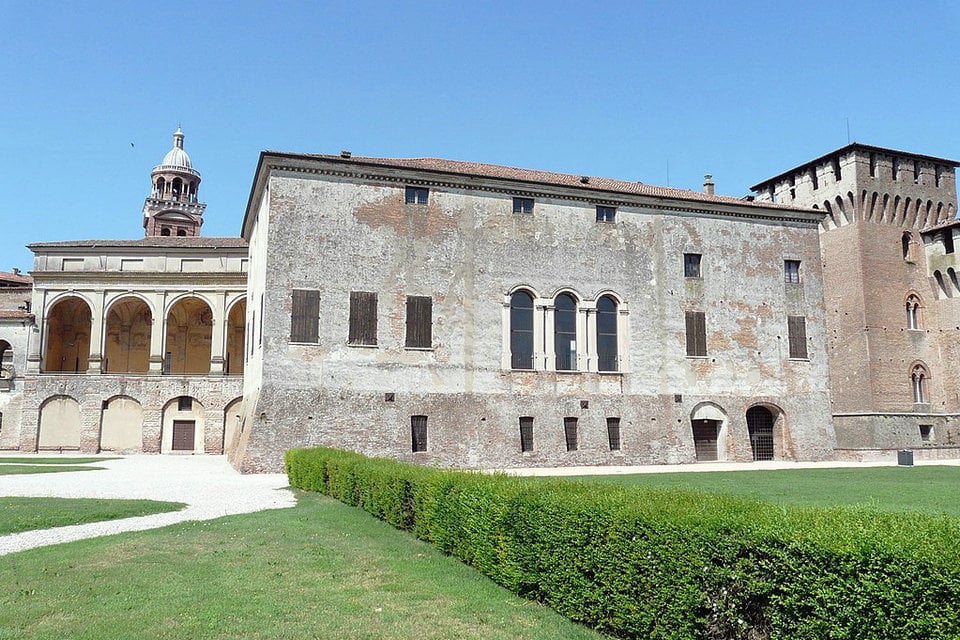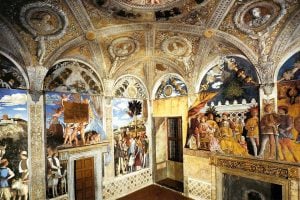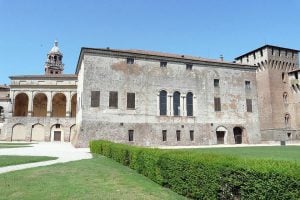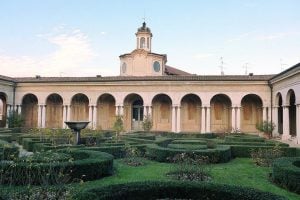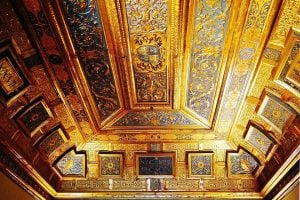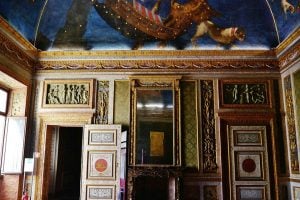The Grande Apartment of Castello was commissioned by Duke William I (1550-1587) as a representative environment; the decorative plant aims to enhance its lineage and the most important military feats of its ancestors, famous Italian condottieri. It consists of the Sala dei Capitani, the first Lords of Mantua from 1328 to 1432; of the Sala dei Marchesi, a title acquired in 1432; and the Sala dei Duchi, a title acquired in 1530 by the father of Guglielmo, Federico II. The pictorial cycle of the “Fasti Gonzagheschi”, composed of eight paintings by Jacopo Tintoretto and aids between 1579 and 1580, now in the High Pinakothek in Munich was originally displayed in the rooms. The apartment is the work of the famous architect Giovanni Battista Bertani, a collaborator of Giulio Romano and his Neapolitan help Pirro Ligorio.
The new court
This nucleus includes several buildings built from the 16th century and aggregated over time to the oldest factories. From the Castle it is possible to access, through the Scalone di Enea, to the Sala di Manto, the party environment that is part of the Grande Castello di Castello built by the duke Guglielmo. From the princely hall you enter the New Court Apartment inhabited by Duke Federico II, which includes the Sala dei Cavalli, the Sala delle Teste and the Sala di Troia (decorated with frescoes by Giulio Romano and his workshop), as well as by the Chamber dei Cesari and a lovely hanging garden, called dei Cani. Cross the Galleria dei Marmi or dei Mesi, which overlooks the Cortile della Cavallerizza, to go along the long Galleria della Mostra that leads to the Appartamento giuliesco called dell’Estivale or della Rustica.
The majestic Sala di Manto, the party hall of Duke Guglielmo. The Appartamento di Troia with the heroic scenes of the Giulietta inspired by the events of the war between the Trojans and the Greeks. The Galleria della Mostra is also sumptuous, where in the 16th century XVII century were found the Gonzaga collections: here was preserved the Death of the Madonna of Caravaggio, purchased by Rubens for the duke Vincenzo I.
Large Apartment Castello
Appartamento Grande di Castello is composed of six rooms.
Manto room
The hall of Manto is inside the New Court. Originally it was the entrance to the Troia apartment which owes its name to the frescoes in the main hall due to the work, between 1538 and 1539, of collaborators of Giulio Romano (Luca di Faenza) who was commissioned by Federico II Gonzaga di to restructure numerous rooms of the Ducal Palace. The present appearance of the Manto Room is due to the intervention of Guglielmo who ordered the creation of the Grande di Castello apartment. The frescoes in the room tell the story of the foundation of the city preceded by the arrival in Italy of Manto, legendary daughter of the fortune teller Tiresias. The birth of the city due to his son Ocno and other urban works undertaken by the Gonzagas is then represented. Frescoes attributed to Francesco Primaticcio.
House of Metamorphosis
Built in 1616 by Antonio Maria Viani, it is so named for the ceiling decorations whose subjects derive from Ovid ‘s Metamorphoses. Composed of four rooms, dedicated to the four natural elements of the earth, water, air and fire, the apartment contained the rich library of the Gonzaga family, dispersed during the sack of Mantua in 1630, and Rinaldo’s embalmed body Bonacolsi known as the Passerino, who had been killed in 1328 when the Gonzaga family gained power over the city of Mantua.
Apartment of the Rustica, Estivale or of the Mostra
Commissioned by Federico II Gonzaga as a residence for illustrious guests of the Mantuan court, the project and the beginnings of the construction works were carried out by the architect Giulio Romano from the year 1539. The Palazzo della Rustica was later completed by Giovan Battista Bertani around 1561. It consists of seven rooms:
Jupiter’s love room
Room of the two columns
Room of the shelves
Hall of fruits
Room of the four columns
Fish Room
Camerino di Orfeo
Other rooms of Corte Nuova
Galleria della Mostra, with the imposing wooden ceiling, almost 7 meters wide and 64 meters long, was built at the beginning of the 17th century by Giuseppe Dattaro commissioned by Vincenzo I Gonzaga. It is the largest in the palace and was to house the Gonzaga collections of precious objects. A plaque inside the great hall recalls the American Henry Kress who generously contributed to the restoration of the Ducal Palace in the early twentieth century.
Sala dei Cavalli, with canvases that celebrated the Gonzaga horses
Salt of the Heads
Cabinet of the Caesars
Gallery of the Marbles or of the Months, with the geniuses and the signs of the Zodiac, initial work of Giulio Romano
Room of the Captains
Room of the Marquises, with sculptures by the Marquis Gonzaga and their wives by the Venetian Francesco Segala
Stanza dei Duchi, by Giovan Battista Bertani, which contained eight large paintings Fasti gonzagheschi commissioned by Guglielmo Gonzaga to Tintoretto and still preserved at the Alte Pinakothek in Munich
Santa Barbara corridor
The staircase of Aeneas
Work by Bertani from 1549 – recently elected by Cardinal Ercole Gonzaga as “Prefect of the Ducal Factories” – directly connects the Salone di Manto with the castle of San Giorgio. At the end of the staircase you enter the courtyard of the castle and its loggia, by Luca Fancelli from 1472.
Italian condottieri
A condottieri is a person who leads an army or a people. The term has strong use and military connotation, but the role and function has sometimes acquired, throughout history, also political and religious functions.
In the first two centuries of the second millennium AD mercenary armies were formed by the Pope to fight Muslim and Arab “infidels” in the Holy Land. These expeditions were called ” crusades ” and in all of history there were 8.
Beginning in the fourteenth century, thanks to the upheavals and tumults of the time, Italian states witnessed the formation of real “military schools” that brought remarkable strategic and tactical progress to war. These schools are called venture companies and each of them has, precisely, a captain of fortune. The soldiers who were part of it were called soldiers of fortune, and for the most part they were mercenaries, or militated for the one who was able to offer him the highest financial compensation, for the exclusive purpose of deriving an advantage for his own advantage. Given the number of soldiers, the company was divided into various ranks, each led by one or more soldiers of greater experience and ability, called condottieri, who were in turn subjected to the captain of fortune. More precisely, the term “condottiero” takes its name from the ” conduct “, that is, from the contract that stipulated the military man with a government to put himself at his service.
Among the first venture companies we highlight the Compagnia della Colomba, formed in 1333, where soldiers from Perugia and Arezzo met, and the Compagnia di San Giorgio, founded six years later with Lodrisio Visconti and re- founded in 1377 by Alberico da Barbiano. In 1347 the leader and politician Cola di Rienzo favored the development of the semi-national military army with the birth of the White Company, a congregation composed of over thirty thousand members. Until that time, most of the armies consisted of foreign soldiers or prisoners of war, now the army slowly began to become national, that is formed by soldiers almost all coming from Italy. But often it happened that these new commanders rebelled against their lord, as happened with the noble Hungarian lineage of the Landaus, whose greatest exponent was Count Lando, deposed by commanders Alberto Sterz and Giovanni Acuto, always referred to by Machiavelli in his treatise Il Prince. Meanwhile, until the end of the fifteenth century, in Italy and in Europe, new military societies continued to develop, such as the most famous Society of the Rose (or Compagnia della Rosa), directed by Giovanni da Buscareto and Bartolomeo Gonzaga.
Later many captains and commanders began to consider the heroic act of throwing themselves into battle, with the risk of dying, unnecessary and began to reconsider “military science”, trying to win wars with cunning. There were also certain commanders who, becoming very powerful, overthrew their masters to take control of the lands and cities: these were, for example, Braccio da Montone and Muzio Attendolo Sforza. With these the armies were modernized, almost all adopting new fighting techniques and military strategies (Niccolò Machiavelli, deepening this change, will write the treatise Arte della guerra in the 16th century); on the threshold ofRenaissance, by now the results of the battles counted a smaller number of losses both human and instruments of war.
Ducal Palace
On account of its size, with more than 900 rooms in total, and for its masterpieces, the Ducal Palace of Mantua is a building like no other in Europe. It boasts untold artistic riches: the Camera degli sposi, featuring fresco paintings by Andrea Mantegna, Pisanello’s frescoes of courtly life, Flemish tapestries from cartoons by Raphael, an altarpiece by Rubens, paintings by Domenico Fetti, a collection of 14th century artworks, as well as the beautiful wooden inlays and frescoes – ranging from the age of the Renaissance to the 18th century – that adorn the studiolo of Isabelle d’Este. Gardens, internal courtyards, decorative elements, the Temple of Santa Barbara, the view of the lakes. A complex that burst to fruition as soon as the Gonzaga family seized power and that was constantly developed, with renovations of the oldest buildings, until the age of the Empress Maria Theresa.
Mantova Urban Museum
A city raised on the shores of beautiful lakes which in the past encircled and decorated it. A city celebrated by Virgil who was born in Andes: “I will raise a marble temple in the green countryside”. A city which hosts the most ancient christian relic, Jesus’ Blood that drained on Longino’s lance. A free city, raised in spite of matildic domination. A miracle of the Reinassance which has its center in the Ducale Palace and in the “Camera Picta” by Andrea Mantegna. A sixteenth century court which has collected infinite masterpieces, while the music and the theatre created unique moments.
Finally, a city which hosted treasures, part of many ages and cultures, in the Teresiana Library, in the National Archive, in the museums. All these elements explain, together with Festilavletteratura, the title of Italian Capital of Culture 2016.
